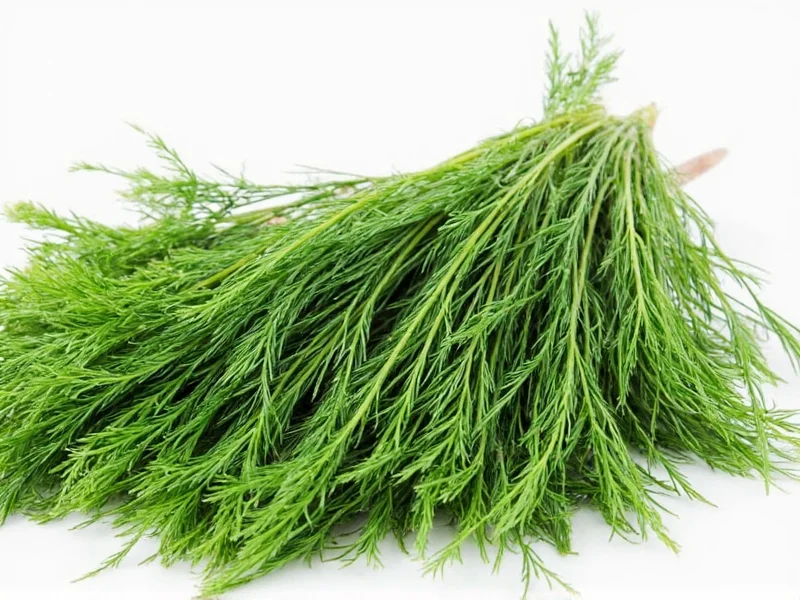Understanding herb conversions is essential for consistent cooking results. When substituting dried dill for fresh in recipes, this precise measurement ratio ensures your dishes maintain proper flavor balance without becoming overpowering or bland. The difference stems from moisture content—fresh dill contains about 85% water, while dried dill has most moisture removed, concentrating its aromatic compounds.
Why Dried and Fresh Dill Require Different Measurements
Dill's flavor profile changes significantly during the drying process. Fresh dill has a bright, grassy flavor with citrus notes, while dried dill develops deeper, more earthy characteristics. The concentration difference isn't arbitrary—it's based on scientific measurement of volatile oil content. Studies show dried dill contains approximately three times more flavor compounds by volume than its fresh counterpart.
Chef Maria Rodriguez, a culinary instructor with 15 years of herb specialization, explains: The key isn't just the measurement ratio but understanding when to adjust it. Delicate dishes like cucumber salad need more careful substitution than robust recipes like dill pickles, where flavor intensity matters less.
| Dried Dill | Fresh Dill Equivalent | Best Used In |
|---|---|---|
| ¼ teaspoon | ¾ tablespoon | Dressings, dips |
| ½ teaspoon | 1½ tablespoons | Fish dishes, sauces |
| 1 teaspoon | 1 tablespoon | Standard conversion |
| 1 tablespoon | 3 tablespoons (¼ cup) | Pickling, hearty stews |
Practical Substitution Guidelines
While the 1:3 ratio serves as your foundation for how to substitute dried dill for fresh dill, consider these factors for optimal results:
Timing Matters
Add dried dill early in cooking to allow rehydration and flavor distribution. Fresh dill works best added near the end to preserve its delicate flavor. For cold dishes like potato salad, let dried dill steep in dressing for 15 minutes before mixing with other ingredients.
Flavor Intensity Adjustments
Store-bought dried dill loses potency over time. Test older dried dill by rubbing a pinch between your fingers—if the aroma is weak, increase by ¼ teaspoon. Fresh dill from your garden may be more potent than store-bought, requiring slight reduction.
Dish-Specific Considerations
Understanding when fresh dill equivalent to dried dill needs modification prevents culinary mishaps:
- Pickling: Use exact 1:3 ratio—dill's flavor penetrates brine effectively
- Fish dishes: Reduce dried dill by 25% to avoid overpowering delicate flavors
- Dips and dressings: Increase fresh dill by 20% when substituting for dried
- Baked goods: Use dried dill exclusively as fresh dill's moisture affects texture
Common Substitution Mistakes
Many home cooks make these errors when converting dried dill to fresh dill:
Mistake 1: Using equal measurements (1:1 ratio). This creates overwhelmingly strong flavor that dominates dishes. Remember that dried dill to fresh dill conversion chart always follows the 1:3 principle.
Mistake 2: Adding dried dill at the same stage as fresh. Dried herbs need time to rehydrate—add them when liquids reach simmering point.
Mistake 3: Not adjusting for recipe moisture content. In low-liquid dishes like breads, reduce dried dill by 15% to prevent concentrated flavor pockets.
When Fresh Dill Makes the Critical Difference
Some recipes absolutely require fresh dill for authentic flavor. Scandinavian gravlax, Greek tzatziki, and fresh cucumber-dill salads lose their characteristic brightness with dried dill substitution. The volatile compounds that give fresh dill its distinctive aroma dissipate during drying, creating a fundamentally different flavor profile.
Conversely, dried dill works better in long-cooked dishes like borscht or dill-infused vinegars where extended cooking would diminish fresh dill's delicate flavor. For these applications, understanding what is the ratio of dried dill to fresh dill ensures proper initial measurement.
Storing and Maximizing Herb Potency
Proper storage affects your dill substitution accuracy. Keep dried dill in airtight containers away from light and heat—properly stored, it maintains potency for 1-2 years. Fresh dill lasts 7-10 days refrigerated with stems in water (like flowers). Freezing fresh dill in oil preserves flavor better than drying for future use.
When measuring dried dill, fluff it before scooping to avoid compacted measurements. For fresh dill, measure after chopping but before packing—lightly fill the spoon without pressing down. These small techniques significantly impact your cooking with dried versus fresh dill outcomes.
Frequently Asked Questions
Can I use dried dill instead of fresh in tzatziki?
While possible, dried dill significantly alters tzatziki's flavor profile. The fresh herb's bright notes are essential to this Greek sauce. If substituting, use 1 teaspoon dried dill per cup of yogurt and add ½ teaspoon lemon zest to compensate for lost brightness.
Why does my substitution make food taste bitter?
Bitterness usually indicates using too much dried dill. Remember the dried dill to fresh dill conversion ratio is 1:3—using equal amounts creates overpowering flavor. Reduce dried dill by 25% and add a pinch of sugar to counteract bitterness in finished dishes.
Does the conversion differ for dill seeds versus dill weed?
Yes—dill seeds have stronger flavor than dill weed (the leafy part). For seeds, use ½ teaspoon dried seeds to replace 1 tablespoon fresh dill weed. Seeds work better in pickling, while weed substitutes better in fresh applications.
How do I adjust recipes when using home-dried dill?
Home-dried dill typically retains more flavor than commercial products. Start with 25% less than the standard dried dill to fresh dill conversion ratio, then adjust to taste. Air-dried herbs maintain about 20% more essential oils than oven-dried.
Can I substitute fresh dill for dried in baking?
Use caution—fresh dill's moisture affects baked goods' texture. For breads and crackers, replace each teaspoon of dried dill with 1 tablespoon fresh dill, but reduce other liquids by 1 teaspoon per substitution. Better yet, use dried dill in baking for consistent results.











 浙公网安备
33010002000092号
浙公网安备
33010002000092号 浙B2-20120091-4
浙B2-20120091-4